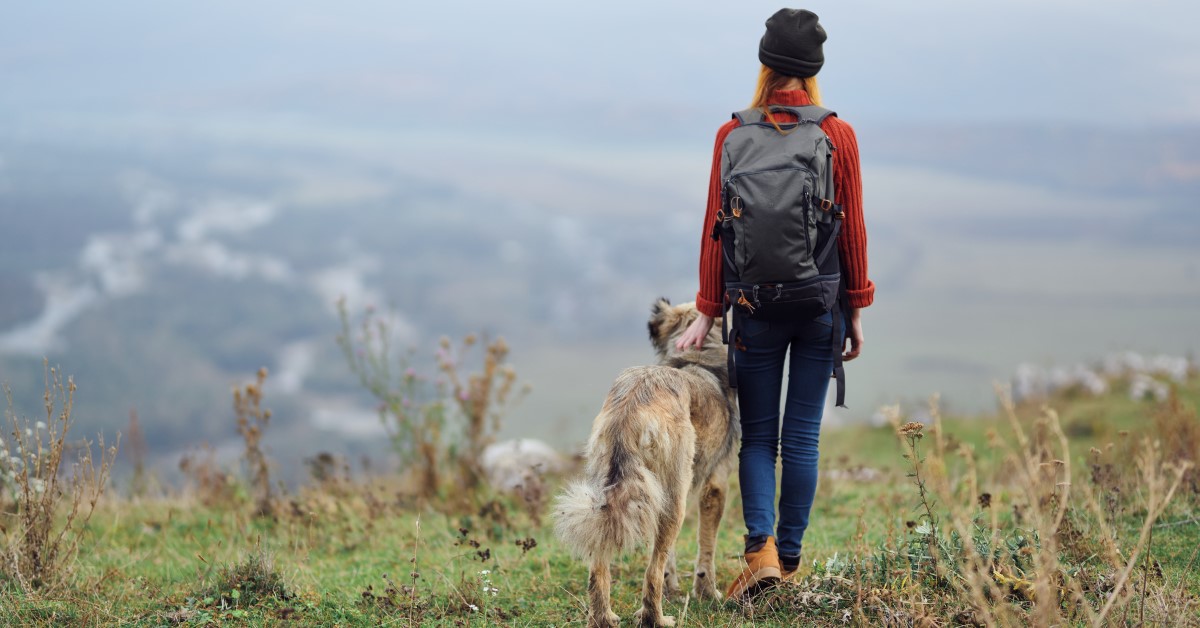How to Prepare your Dog for a Hike
Now that it’s fall, I want to take my dog hiking. Is there anything special she needs?

Fall is the perfect time for hiking. The weather has cooled down, the leaves are changing color, and the bugs are no longer swarming. Your dog probably loves getting out in nature just as much as you do. But before you take to the trails, make sure you are properly prepared.
First, can your canine companion handle a hike? If you regularly take her on longer walks, she can probably handle hiking a few miles. However, if she is an overweight couch potato who hasn’t walked more than a block in over a year, even a short hike could be dangerous for her. Just like humans, dogs need to get in shape. Start with short walks and gradually ease her into exercise. If she is a puppy and still growing, you also need to be cautious. Your puppy may have enough energy to run to the top of the mountain, but if she is still young and growing, too much activity can cause damage to her still-developing joints. If she is an older dog, she may be starting to develop arthritis in her joints. If she limps when she first gets up or takes a few days to recover from running and playing, talk to your veterinarian before going on a strenuous hike.
Once you have determined that your dog can physically handle a hike, make sure she is prepared medically. Is she up to date on all the recommended vaccines? All dogs should be vaccinated against rabies, distemper, and parvo. Beyond these core vaccines, the recommended vaccines depend on where you live and what you might encounter on your hike. In my part of the country, we see a lot of Lyme and Leptospirosis, so I advise all my canine patients to be vaccinated for these diseases. My vet friends in the southern United States may recommend the rattlesnake vaccine. Other areas may be hotbeds for canine influenza, and the flu vaccine may be a good idea.
In addition to vaccines, ask your veterinarian what preventative medications they advise you use. A good tick preventative is essential where I live. Areas that see more heartworm disease may suggest a product to repel mosquitos in addition to heartworm preventative.
Now that your dog is prepared medically, it’s time to find the right trail. Before you go, find out the rules of the trail. Are dogs allowed on the trail? Do they always need to be on a leash, or can they run without a leash? How popular is the area? Will your dog be friendly if you encounter other dogs, or do you need to find a less popular hike? Can your dog handle the terrain?
Finally, make sure you have everything you need—pack enough water, not only for yourself but also for your furry companion. Bring along a bowl she can drink from. If space is tight, many types of collapsible dog bowls can easily be packed into a small backpack. Try to keep your dog from licking out of puddles, creeks, streams, and lakes along the way. Even though the water may look cool and refreshing, it could be home to parasites or bacteria that can cause vomiting and diarrhea. Depending on how long you plan on hiking, you may want to pack some treats or kibble for when she gets hungry. A towel may be nice to wipe off muddy paws before your doggy jumps back into the car. Don’t forget to pack some biodegradable poop bags. No one likes to step in doggy poo!
Be safe and have fun on your hiking adventures. Remember the Number One rule of The Great Outdoors – “Take only photographs, leave only footprints.”
Ready to start saving money on pet wellness care?
Then take a look at Mint Wellness, the pet wellness plan that provides fast reimbursement on routine pet care. Save on vaccinations, wellness exams, preventatives, dental, and more!
Learn More


